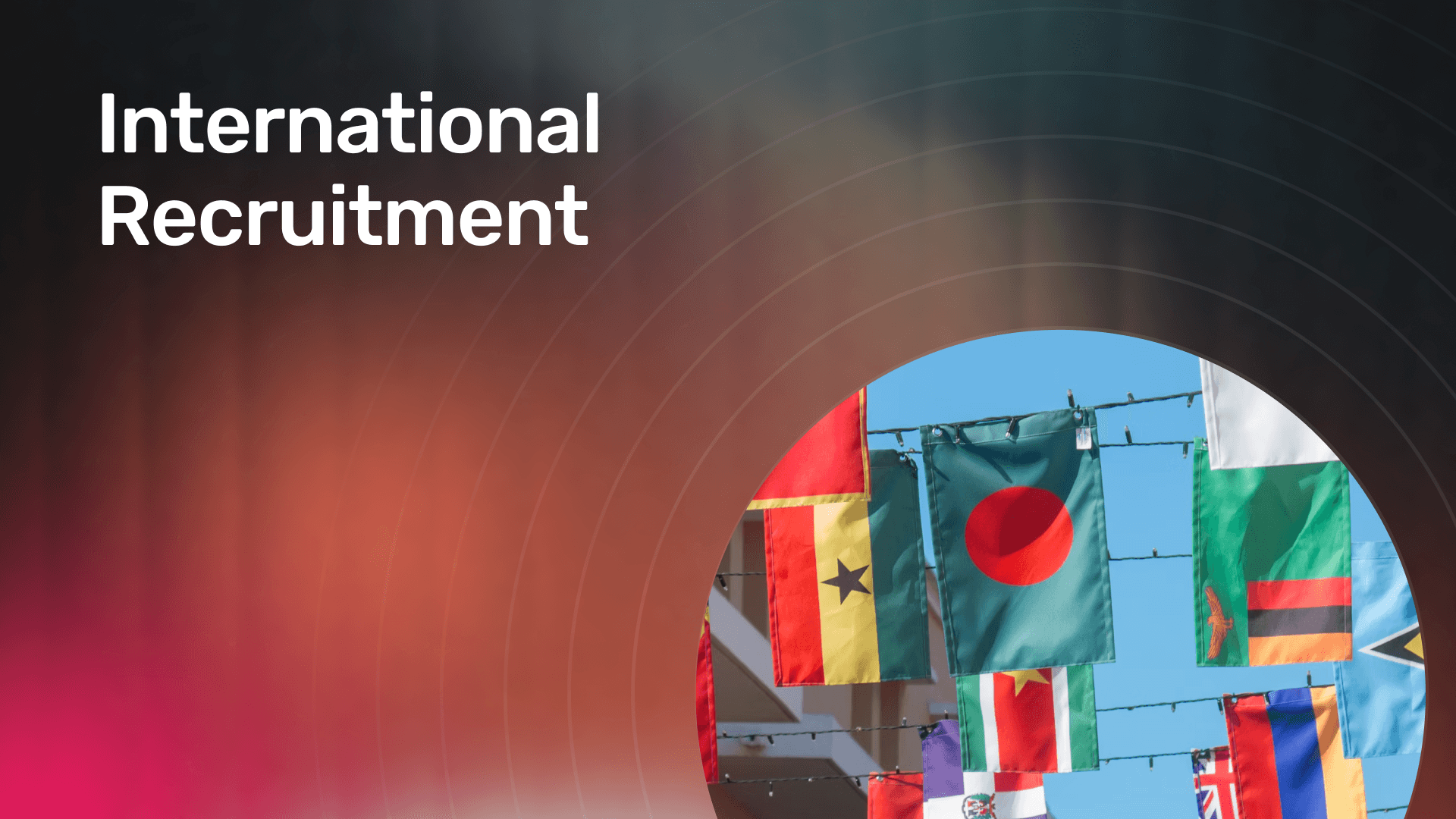International Recruitment: How to Adapt Your Hiring Process for Different Countries
Hiring talent from different countries is an exciting way to grow your business, bring in new ideas, and reach global markets. But it’s not as simple as copying your local hiring process. International recruitment comes with its own set of challenges—from legal compliance to cultural fit.
To build a strong global team, you need a hiring strategy that works across borders. In this guide, we’ll walk you through the key steps to adapt your hiring process for international recruitment.

What is international recruitment, and why is it important?
International recruitment is the process of hiring employees from different countries. It allows companies to tap into a broader talent pool, improve diversity, and fill skill gaps that may not be possible locally. It’s especially important in our remote-first world, where location matters less, but laws, cultures, and expectations still do.
Expanding your team globally also helps increase innovation by bringing in diverse perspectives and ideas. Businesses that invest in international hiring can build more resilient teams, explore new markets, and remain competitive in the global economy. In short, international recruitment is no longer a bonus; it’s becoming a business necessity.

Common challenges in international recruitment
Before you adapt your process, it’s helpful to understand what can go wrong. Here are some common pain points:
- Time zone coordination can cause delays in communication and interviews, affecting candidate experience.
- Cultural misunderstandings can influence how candidates interpret your communication or respond in interviews.
- Legal and compliance hurdles may lead to unintentional violations if you're unfamiliar with local regulations.
- Local market dynamics may be unfamiliar, such as salary benchmarks, job title variations, or preferred hiring platforms.
- Remote candidate experience may suffer without proper onboarding or consistent engagement.
- Lack of internal alignment can result in confusion around process ownership or hiring expectations across countries.
Steps to adapting your international hiring process
Understand the legal and compliance requirements
Hiring internationally means dealing with a whole new set of laws and regulations.
Things to keep in mind:
- Employment laws: Each country has different rules about work hours, contracts, termination, employee rights, and more.
- Visa and immigration requirements: If you're relocating someone, you’ll need to deal with permits and paperwork.
- Data privacy and protection: Countries like those in the EU have strict data laws (like GDPR), so you must be careful with candidate data.
- Taxation and payroll: You’ll need to handle local taxes, contributions, and ensure employees are paid correctly and on time.
- Background checks: Some checks may be illegal or restricted in certain countries.
How to make it happen:
- Work with legal experts or use an Employer of Record (EOR) service that can manage compliance for you.
- Stay updated on international employment laws and regulations
- Document every step of your hiring and onboarding process to avoid future legal issues.
Respect cultural differences
What works in one country might feel awkward or even rude in another. Understanding cultural norms is key to attracting and hiring the right people.
Things to keep in mind:
- Communication styles: Some cultures value directness, others prefer a more polite or indirect approach.
- Interview etiquette: In some countries, it’s common to jump straight into the conversation. In others, small talk and formal greetings matter.
- Decision-making processes: Some candidates may prefer collective decisions involving family or senior mentors.
- Work-life balance expectations: What’s considered a “normal” workload varies greatly.
- Values and motivations: Job stability, growth opportunities, or even social recognition can drive candidates differently depending on where they’re from.
How to make it happen:
- Provide cultural sensitivity training to your recruiters and interviewers.
- Localise your communication in job ads, emails, and interviews.
- Partner with local experts who understand candidate behaviour.
- Adapt your interview process to make candidates feel comfortable and respected.

Craft culturally relevant job descriptions
A job ad that works well in one country might not get noticed in another. You need to speak the local language—literally and culturally.
Things to keep in mind:
- Language and tone: Avoid slang or overly casual language that may not translate well.
- Content and focus: In some cultures, job security might be more attractive than innovation or fast growth.
- Channels and platforms: LinkedIn might be popular in some countries, but others may prefer local job sites or referrals.
- Visuals: Even images and branding can have different meanings across cultures.
How to make it happen:
- Use local job boards and adapt your messaging accordingly.
- Tailor your employer brand to align with what local candidates care about.
- Test and get feedback on your job posts from people in the target market.
Adapt your sourcing strategies
You’ll need a different approach to find the right people in different regions.
Things to keep in mind:
- Global talent mapping helps you understand where the skills you need are most available.
- Virtual recruitment events are a great way to connect with candidates across time zones.
- University partnerships can help you reach fresh talent in local markets.
- Time zone differences matter when scheduling interviews or outreach.
How to make it happen:
- Use global sourcing platforms to expand your reach.
- Train your recruiters to think beyond local talent pools.
- Build partnerships with regional recruiters or agencies who know the landscape.
Optimise your interview process
Remote hiring brings new challenges when it comes to communication, scheduling, and evaluating candidates fairly.
Things to keep in mind:
- Ensure you have the right technology; laggy video calls leave a bad impression.
- Time zone coordination is essential for smooth communication.
- Use virtual assessments for technical roles or soft skills.
- Conduct structured interviews to reduce bias.
- Clearly explain your interview steps to avoid confusion.
How to make it happen:
- Invest in stable video conferencing tools and assessment platforms.
- Train your interviewers in remote and cross-cultural interviewing.
- Do trial runs of your process and fix any tech or timing issues.
To learn more about how to successfully conduct remote interviews, read our guide on the best practices of remote hiring.

Build competitive compensation and benefits packages
What’s considered “competitive” in one country might not be attractive in another. To attract and retain good talent, building a comprehensive benefits package is very important.
Things to keep in mind:
- Salary benchmarking is essential; do local market research.
- Factor in the cost of living in each location.
- Offer relevant benefits and perks, such as healthcare, vacation time, and flexible working hours.
- Comply with local legal requirements for things like pensions or insurance.
- Currency exchange rates can affect how a salary is perceived.
How to make it happen:
- Use tools or partners to benchmark salaries globally.
- Consider using an EOR (Employer of Record) provider like Native Teams to manage local payroll and benefits.
- Be transparent with candidates about what’s included and how it compares to local standards.
Onboard your international hires
A great first impression goes a long way. A strong employee onboarding plan helps international employees feel part of the team from day one.
Things to keep in mind:
- Remote employees need clear, structured onboarding processes.
- Cultural integration helps people connect with your company’s values.
- Plan regular check-ins to ensure engagement and understanding.
- Help them understand local work norms, holidays, and expectations.
- Support team bonding across locations.
How to make it happen:
- Create a remote onboarding playbook with clear steps and resources.
- Offer mentorship programmes that pair international hires with local teammates.
- Build a knowledge base or portal with helpful information for new hires.

Simplify international recruitment with Native Teams
Hiring across borders can be complicated, but it doesn’t have to slow you down. Native Teams makes international recruitment simple, secure, and scalable.
Our all-in-one platform lets you hire and manage employees in 85+ countries without needing to set up local entities. From compliant contracts and automated payroll to tax handling and employee benefits, we take care of the heavy lifting so you can focus on building your team.
Whether you're onboarding one remote employee or scaling a global workforce, Native Teams gives you the tools and local expertise to hire confidently, anywhere in the world.
Final thoughts
International recruitment isn’t just about reaching more people; it’s about doing it right. By adapting your hiring process to local laws, cultures, and expectations, you’ll not only attract better talent but also create a more inclusive and productive team. It may take extra effort at first, but the rewards, in terms of team performance, reputation, and reach, are well worth it.
Start slow, stay flexible, and remember: great people are everywhere, you just need the right approach to find and support them.
